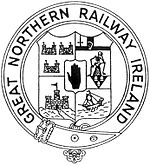Great Northern Railway (Ireland)
 |
|
| Industry | Rail transport |
|---|---|
| Fate | Dissolved |
| Predecessor |
Irish North Western Railway Northern Railway of Ireland Ulster Railway |
| Successor |
Ulster Transport Authority Córas Iompair Éireann |
| Founded | 1876 |
| Defunct | 1958 |
| Parent | Great Northern Railway Board |
The Great Northern Railway (Ireland) (GNR(I) or GNRI) was an Irish gauge (1,600 mm (5 ft 3 in)) railway company in Ireland.
The Great Northern was formed in 1876 by a merger of the Irish North Western Railway (INW), Northern Railway of Ireland, and Ulster Railway. The Ulster Railway was the GNRI's oldest constituent, having opened between Belfast and Lisburn in 1839 and extended in stages to reach Clones in 1863. The Northern Railway of Ireland was itself formed by a merger of the Dublin and Drogheda Railway (D&D) with the Dublin and the Belfast Junction Railway (D&BJct).
The Ulster, D&D and D&BJct railways together formed the main line between Dublin and Belfast, with the D&BJct completing the final section in 1852 to join the Ulster at Portadown. The GNRI's other main lines were between Derry and Dundalk and between Omagh and Portadown. The Portadown, Dungannon and Omagh Junction Railway together with the Londonderry and Enniskillen Railway enabled GNRI trains between Derry and Belfast to compete with the Belfast and Northern Counties Railway, and both this and the Dundalk route gave connections between Derry and Dublin. These main lines supported the development of an extensive branch network serving the southwest half of Ulster and northern counties of Leinster. The GNRI became Ireland's most prosperous railway company and second largest railway network.
...
Wikipedia
